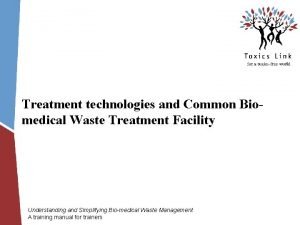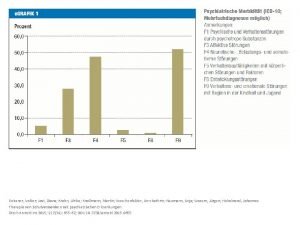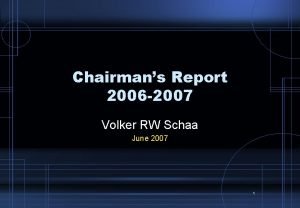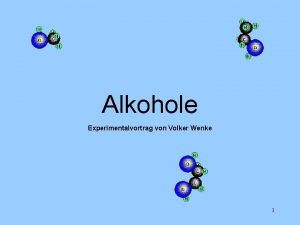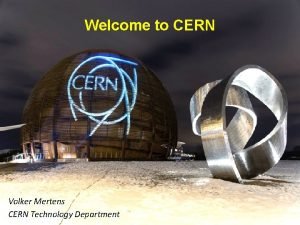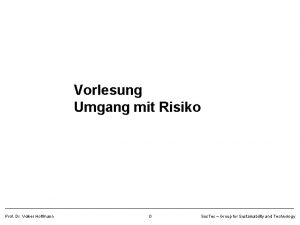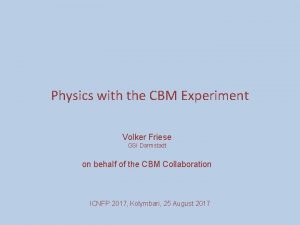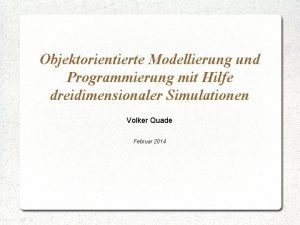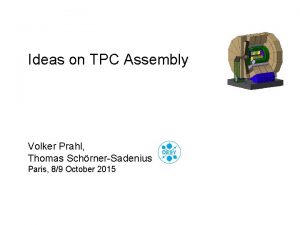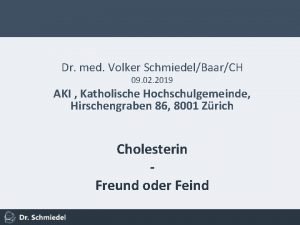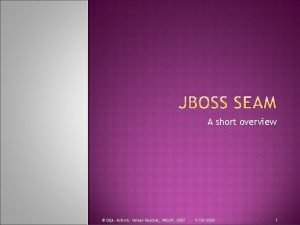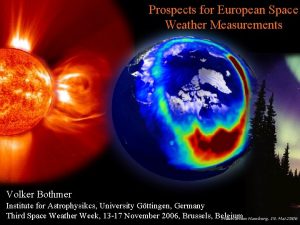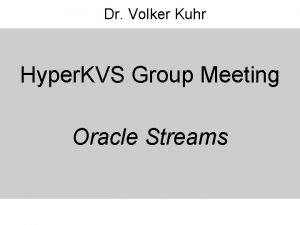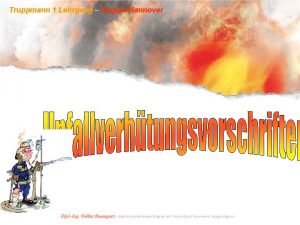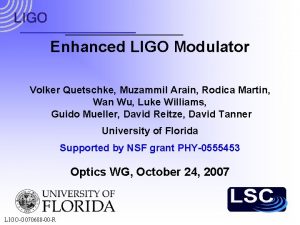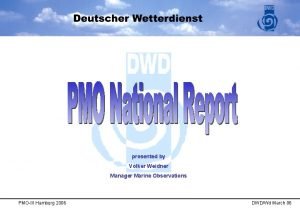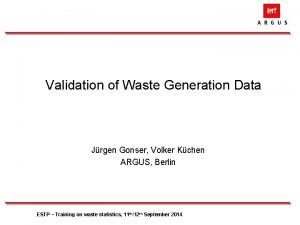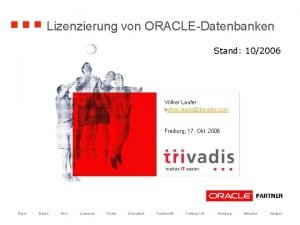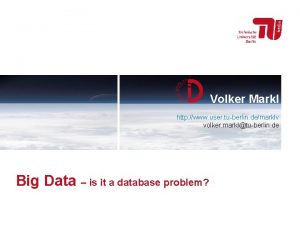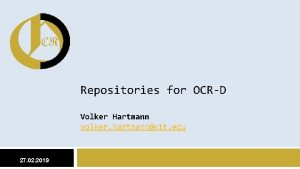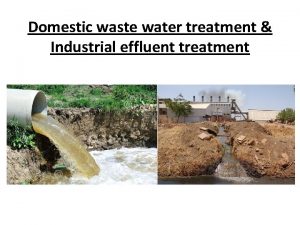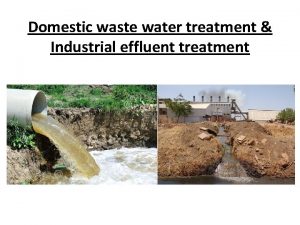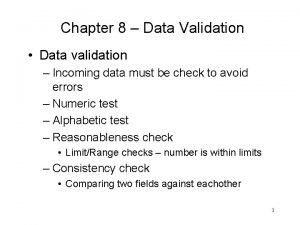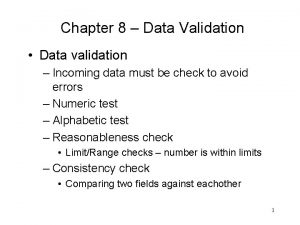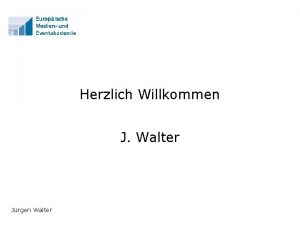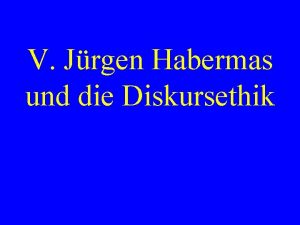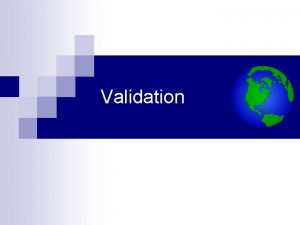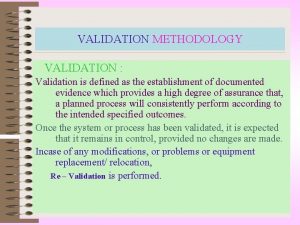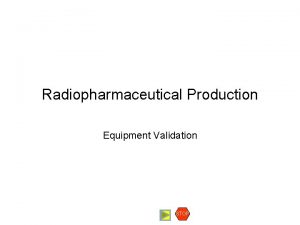Validation of waste treatment data Jrgen Gonser Volker


























- Slides: 26

Validation of waste treatment data Jürgen Gonser, Volker Küchen ARGUS, Berlin ESTP – Training on waste statistics, 11 th/12 th September 2014 1

Agreed validation rules 1. Comparison over time a) (total /hazardous) waste generation by NACE b) hazardous share by NACE c) treatment by operation (WST_OPER) d) generation & treatment by waste category (WASTE) e) relation treatment / generation by waste category f) generation & treatment: largest differences for inner cells 2. Relation treatment / generation (totals) 3. Implausible combinations treatment operation / waste categories 4. Treated amounts vs. treatment capacities (incineration) ESTP – Training on waste statistics, 11 th/12 th September 2014 2

1 c) Total waste treatment by operation § Assumption: Total & hazardous waste by treatment operation is stable over time. § Data level: Analysis carried out for 6 treatment operations (WST_OPER) and total treatment. § Calculations: o Calculation of the ratio of the amounts treated of the current year and those of the previous reference year: § Thresholds: o lower threshold: ratio current/previous < 0. 8 o upper threshold: ratio current/previous > 1. 2 ESTP – Training on waste statistics, 11 th/12 th September 2014 3

1 c) Total waste treatment by operation Cells that are targeted by validation check 1 c (green cells) 1 Item 1 2 3 4 … … 48 49 50 51 Total Waste W 011 W 012 W 013 … … W 127 W 128_13 Type of recovery and disposal operations (item, description) 2 3 a 3 b 4 Other Hazard Incineration / recovery (excl. Backfilling energy disposal recovery and recovery (R 1) (D 10) backfilling) (R 2 - R 11) 5 Land treatment Deposit onto and release or into land into water (D 1, D 5, D 12) bodies (D 2, D 3, D 4, D 6, D 7) Total nhaz haz … … nhaz haz nhaz total ESTP – Training on waste statistics, 11 th/12 th September 2014 4

1 c) Total waste treatment by operation Spain ES, Landfilling (DSP_D), Total waste § Repeated decrease of the total waste landfilled by more than 20%: - 2006 – 2008: -33% - 2008 – 2010: -23% § Presumed reasons: - Construction activities are low due to economic crisis - Increase of recycling and backfilling - Methodological reasons? ESTP – Training on waste statistics, 11 th/12 th September 2014 100 80 million tonnes § Decrease mainly due to lower amounts of mineral wastes landfilled 120 2004 2006 60 2008 2010 40 20 0 Total waste landfilled 5

1 c) Total waste treatment by operation Slovenia § Presumed reason: Intensive development of separate waste collection and subsequent recovery § Development of recovery corresponds with the decrease of the landfilled waste by 23% from 2008 to 2010 ESTP – Training on waste statistics, 11 th/12 th September 2014 4, 5 4, 0 3, 5 3, 0 million tonnes § Repeated increase of the total waste recovered (excluding energy recovery) by more than 20%: - 2006 – 2008: +51% - 2008 – 2010: +28% SI, Recovery (RCV_NE), Total waste 2006 2, 5 2008 2, 0 2010 1, 5 1, 0 0, 5 0, 0 Total waste recovered 6

1 c) Total waste treatment by operation § Disposal operations have been regrouped in the course of the WStat. R validation as follows: Item Treatment category 4 Deposit into or onto land (DSP_D) 5 Land treatment and release into water bodies (DSP_O) D-codes covered 2004 – 2008 as of 2010 D 1, D 3, D 4, D 5, D 12 D 1, D 5, D 12 D 2, D 6, D 7 D 2, D 3, D 4, D 6, D 7 o D 3 Deep injection (e. g. injection of pumpable discards into wells, salt domes or naturally occurring repositories etc. ) o D 4 Surface impoundment (e. g. placement of liquid or sludge discards into pits, pounds or lagoons etc. ) § Impact: Considerable amounts of mineral mining waste are shifted from ‚landfilling‘ to ‚land treatment and release into water bodies‘ ESTP – Training on waste statistics, 11 th/12 th September 2014 7

1 c) Total waste treatment by operation Sweden § Explanations: - High fluctuation of recovery of mining waste - Decrease of energy recovery due to re-classification of wood waste as by-products - Shift of huge amounts of mining waste from landfilling to land treatment because of WStat. R Revision 2006 2008 2010 70 60 Millions § Changes of more than 20% from 2008 to 2010 for four treatment operations 2004 50 40 30 20 10 0 Recovery Incineration Deposit Land other than / energy onto or into treatment energy recovery land release recovery (R 1) into water bodies ESTP – Training on waste statistics, 11 th/12 th September 2014 8

1 d) Waste treatment by waste category § Assumption: Waste generation and treatment by waste category is stable over time. § Data level: Comparison carried out for each waste item (51 items) and two SDI § Calculations: o Treatment: Calculation of the ratio of the amounts treated for all waste item & two SDIs of the current year and the corresponding values of the previous ref. year: § Thresholds: o lower threshold: ratio current/previous < 0. 5 o upper threshold: ratio current/previous > 2. 0 ESTP – Training on waste statistics, 11 th/12 th September 2014 9

1 d) Waste treatment by waste category Cells that are targeted by validation check 1 d (green cells) 1 Item 1 2 3 4 … … 48 49 50 51 Total Waste W 011 W 012 W 013 … … W 127 W 128_13 Type of recovery and disposal operations (item, description) 2 3 a 3 b 4 Other recovery (excl. Hazard Incineration / Backfilling energy disposal recovery and recovery (R 1) (D 10) backfilling) (R 2 - R 11) 5 Land treatment Deposit onto and release or into land into water (D 1, D 5, D 12) bodies (D 2, D 3, D 4, D 6, D 7) Total nhaz haz … … nhaz haz nhaz total ESTP – Training on waste statistics, 11 th/12 th September 2014 10

1 f) Treatment: largest differences at detailed level § Assumption: All cell values relatively stable over time & by waste category § Data level: Comparison carried out for all cells of datasets GENER and TREATM except ALL totals § Calculations: o Treatment: Calculation of the difference of the amounts treated for all waste items and treatment operations (WST_OPER) of the current year and the values of the previous ref. year: § Thresholds: None: It is proposed to make a list with the 20 -30 largest absolute differences. ESTP – Training on waste statistics, 11 th/12 th September 2014 11

1 f) Treatment: largest differences at detailed level Cells that are targeted by validation check 1 f (green cells) 1 Item 1 2 3 4 … … 48 49 50 51 Total Waste W 011 W 012 W 013 … … W 127 W 128_13 Type of recovery and disposal operations (item, description) 2 3 a 3 b 4 Other Hazard Incineration / recovery (excl. Backfilling energy disposal recovery and recovery (R 1) (D 10) backfilling) (R 2 - R 11) 5 Land treatment Deposit onto and release or into land into water (D 1, D 5, D 12) bodies (D 2, D 3, D 4, D 6, D 7) Total nhaz haz … … nhaz haz nhaz total ESTP – Training on waste statistics, 11 th/12 th September 2014 12

2. Relation treatment / generation (totals) ESTP – Training on waste statistics, 11 th/12 th September 2014 13

2. Relation treatment / generation (totals) Ratio „treatment / generation“ for the total waste by country (2010) ESTP – Training on waste statistics, 11 th/12 th September 2014 14

2. Relation treatment / generation (totals) Ratio „treatment / generation“ for hazardous waste by country (2010) ESTP – Training on waste statistics, 11 th/12 th September 2014 15

2. Relation treatment / generation (totals) Reasons for differences Direction of impact Gross generation (primary and secondary waste) versus final treatment GEN > TRT Treatment includes imported waste and excludes exported waste both directions Loss of weight between generation and final treatment GEN > TRT Time delay between generation and treatment both directions Methodological differences between generation and treatment data (e. g. different coverage) both directions ESTP – Training on waste statistics, 11 th/12 th September 2014 16

2. Relation treatment / generation (totals) Comments to test 2: § There exist several reasons why generation and treatment are not equal § Usually most important: - Import and export, particularly in small countries; - Pre-treatment of waste § BUT: Difference should be limited and explainable! § Relation between generation and treatment reflects whether the concepts of Annex I and Annex II are properly applied § Test may need refinement depending on national conditions and specificities ESTP – Training on waste statistics, 11 th/12 th September 2014 17

1 e) Relation treatment / generation by waste category § Assumption: Relation treatment / generation relatively stable over time and waste category § Data level: Comparison carried out for each waste item (51 items) § Calculations: o Step 1: Calculation of the indicator of the amount treated divided by the amount generated for each waste category for current and previous reference year: o Step 2: Calculation of ratios of the indicators calculated in step 1. § Thresholds: o lower threshold: ratio current/previous < 0. 5 o upper threshold: ratio current/previous > 2. 0 ESTP – Training on waste statistics, 11 th/12 th September 2014 18

1 e) Relation treatment / generation by waste category Distribution of ratio “treatment/generation“ by waste category for non-hazardous waste (based on data of all countries, 2010) ESTP – Training on waste statistics, 11 th/12 th September 2014 19

1 e) Relation treatment / generation by waste category Distribution of ratio “treatment/generation“ by waste category for hazardous waste (based on data of all countries, 2010) ESTP – Training on waste statistics, 11 th/12 th September 2014 20

1 e) Relation treatment / generation by waste category Comments to test 1 e § Test focusses on the time series of the ratio „treatment/generation“, but the ratio itself should also be plausible/explainable § The waste-specific relation between treatment and generation needs further investigation § Application of validation check on country level will provide useful information § Thresholds for validation check may not be narrow enough ESTP – Training on waste statistics, 11 th/12 th September 2014 21

3. Implausible combinations § Assumption: Some treatment operations are unlikely for certain waste materials. § Data level: Certain combinations of all waste item (51 items) and of all 6 treatment operations. § Calculations: None. § Thresholds: None. Combinations defined in the black shaded cells in Table on (next slide). Ø The table overleaf was a first approach and should be revised and approved by the countries based on their experience. ESTP – Training on waste statistics, 11 th/12 th September 2014 22

3. Implausible combinations ESTP – Training on waste statistics, 11 th/12 th September 2014 23

3. Implausible combinations Experience from WStat. R Validation 2010 § Matrix has been a good basis for validation of 2010 data § Some of the implausible combinations occurred but on a low level § Further implausible combinations should be added, e. g. : - other disposal of hazardous waste and or recyclables (06 -07. 6) - backfilling of recyclables (06– 07. 6) and of organic waste (09) - energy recovery and incineration of discarded equipment (08) § Matrix should be revised based on the results of the 2012 validation § Revised matrix could be made available as guidance for validation ESTP – Training on waste statistics, 11 th/12 th September 2014 24

4. Treated amounts vs. treatment capacities § Assumption: The total amount treated is equal to or lower than the available capacity § Data level: Test applied to total amount (NHAZ + HAZ) treated by: – Incineration with energy recovery (R 1) – Incineration without energy recovery (D 10) § Calculations: o Calculation of the ratio of the total amount treated by energy recovery and incineration divided by the capacities of the respective treatment operations: § Thresholds: o lower threshold: None o upper threshold: ratio treatment/capacity > 1. 0 ESTP – Training on waste statistics, 11 th/12 th September 2014 25

Outlook and questions Thank you for your attention! Contact: gonser@argus-statistik. de kuechen@argus-statistik. de ESTP – Training on waste statistics, 11 th/12 th September 2014 26
 Cbwtf full form
Cbwtf full form Volker pispers zitate
Volker pispers zitate Volker markl
Volker markl Volker jost
Volker jost Dr gerd kirchhoff
Dr gerd kirchhoff Volker schaa
Volker schaa Volker wenke
Volker wenke Volker mertens
Volker mertens Prof. dr. volker hoffmann
Prof. dr. volker hoffmann Volker friese
Volker friese Volker quade
Volker quade Wenke lee
Wenke lee Volker prahl
Volker prahl Dr. med. volker schmiedel
Dr. med. volker schmiedel Volker seeker
Volker seeker Vrsoft
Vrsoft Space weather
Space weather Volker kuhr
Volker kuhr Volker römermann ehefrau
Volker römermann ehefrau Truppmann 1
Truppmann 1 Volker iceblue
Volker iceblue Volker quetschke
Volker quetschke Volker weidner
Volker weidner Gis data validation
Gis data validation Gis data validation
Gis data validation Validation checks ict
Validation checks ict Data validation software
Data validation software
